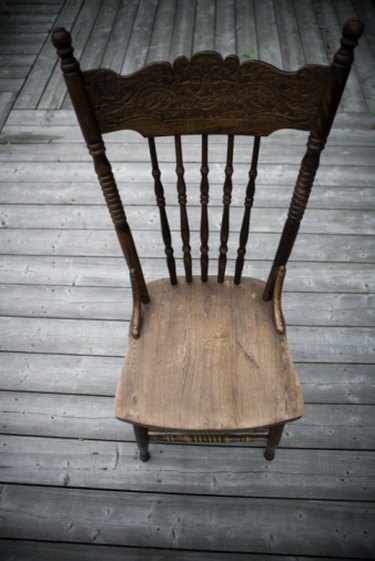Things You'll Need
Screwdriver
Utility knife
Wood glue
Band clamp
Damp cloth
Angle brace
Screws
Drill
Cardboard

Wooden chairs take a lot of abuse and when used on a daily basis the screws may loosen or the stretchers of the chair (horizontal pieces of wood that join the legs) may begin to move. Even when the chair is seldom used, wood will often shrink as it ages and over time the glue can harden and no longer adhere correctly. You may think if a chair starts to wobble or a leg becomes loose that it is time to get a new chair, but with a few simple tools it is often possible to repair the chair and make it usable again.
Loose Stretcher
Step 1
Remove the loose stretcher from the chair. You may have to remove one or both of the legs of the chair to allow access to the loose stretcher. If required, use a screwdriver to remove the screws from where the leg or legs meet the base of the chair.
Video of the Day
Step 2
Scrape the old glue from the stretcher with a utility knife.
Step 3
Apply wood glue to the area of the stretcher that you cleaned the old glue from. Reattach the stretchers to the legs of the chair and the legs to the base.
Step 4
Place a band clamp around the legs of the chair to hold everything in place. Allow the glue to dry for at least 48 hours before removing the band clamp and using the chair.
Step 5
Use a clean damp cloth to wipe away any excess glue that escapes from where you replaced the stretcher.
Loose Legs
Step 1
Examine the chair to see how the legs fit to the base. They are generally either attached with screws or glue. When attached with screws, it is often a simple matter of tightening the screws. If the legs are glued, however, you may wish to add a brace to help tighten the leg back to the base of the chair.
Step 2
Use a screwdriver to tighten the screws of the leg that is loose until the chair no longer wobbles. To keep the other legs from becoming loose, check the screws on the other legs to ensure they are tight as well.
Step 3
Fasten an angle brace to the base of the chair and the leg. Hold the leg of the chair in place against the base and pre-drill the holes on the leg of the chair for the angle brace. Attach the angle brace to the leg with screws. Insert a small piece of cardboard under the other side of the angle. Drill the screw holes for the other side with the cardboard in place. Place the screws into the hole and tighten slightly, but remove the cardboard before driving them in all the way. The gap cause by the cardboard will pull the joint together as you finish tightening the screws into the wood.
Warning
Do not attach an angle brace to an antique chair without first considering its value. Adding metal can reduce the price of what the chair is worth.
If a leg is glued to the base of a chair and it has not yet become completely loose, you may find that you can repair it with wood glue. This method does not typically last for a long period of time, however, if the chair is constantly used.
Video of the Day